AMD's A10-5750M Review, Part 2: The MSI GX60 Gaming Notebook
by Dustin Sklavos on June 29, 2013 12:00 PM ESTDisplay Quality
High dpi displays, even if they're TN panels, tend to perform fairly well, and the 1080p 15.6" panel on the MSI GX60 is at least a healthy one. I feel like at long last we're finally starting to come out of the dark ages of 1366x768 panels; virtually none of the notebooks I've tested recently have had bad or low-resolution panels. With tablets pushing pixel density ever higher and TN panels only showing up on the cheapest of the cheap, the notebook industry has been running out of excuses to fob crappy displays on us. You'll still see them at the lowest and most mainstream price points, but the trickle-down mercifully seems to have begun.
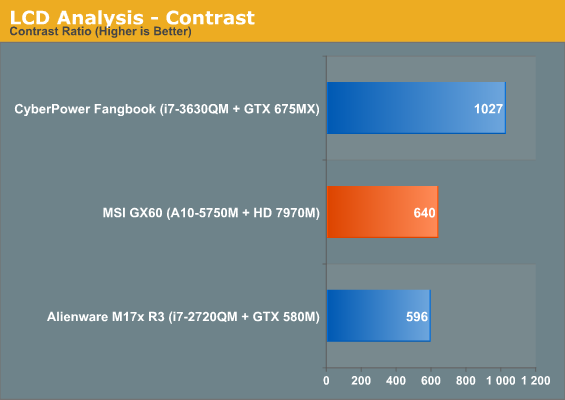
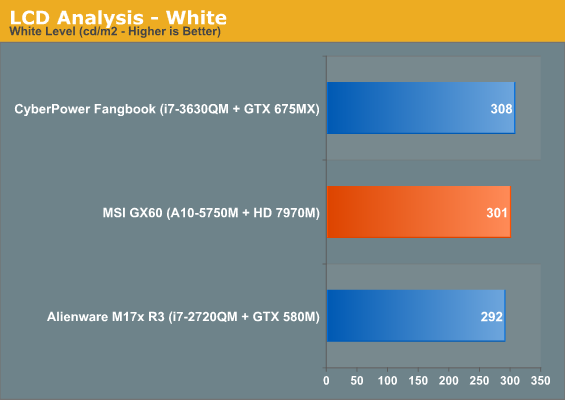
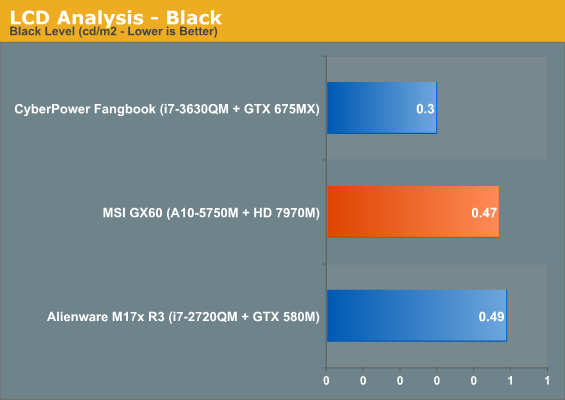
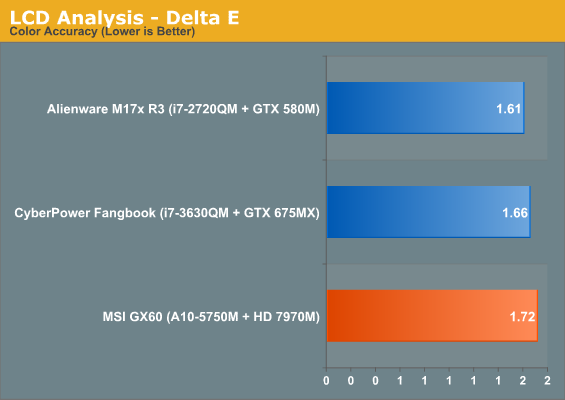
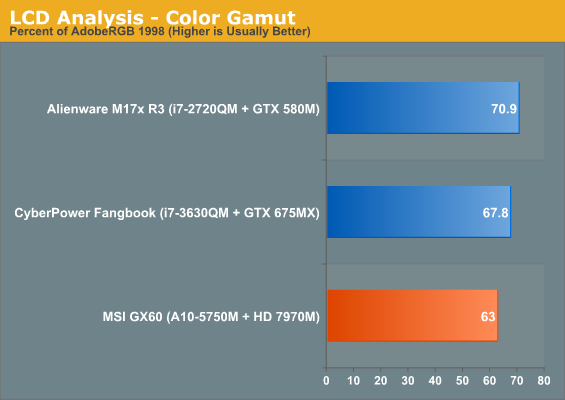

The panel MSI uses for the GX60 isn't exemplary, but the contrast ratio is a far cry from the sub-300 or even occasional sub-200 TN panels of the entry level market. If nothing else, the 1080p display is more than adequate for both gaming and any basic work, and I appreciate that MSI has stuck with the trend in the gaming notebook market of moving towards matte panels. Alienware was the last holdout, but their refreshed line of notebooks doesn't feature glossy displays either.
Battery Life
Unfortunately, perhaps frustratingly, we weren't able to get battery running time results for the original Trinity-based GX60, so MSI's new Richland-based model is stuck in the wilderness. Jarred has also reported continued issues with AMD's Enduro technology, but my experience with it on the GX60 was actually pretty painless. Enduro's interface is still miles behind NVIDIA's Optimus, but I at least have hope now that AMD will be able to compete and level the playing field. As it stands, NVIDIA hardware has been ubiquitous in the notebook space. While that's good for them, consumers need choice and competition.

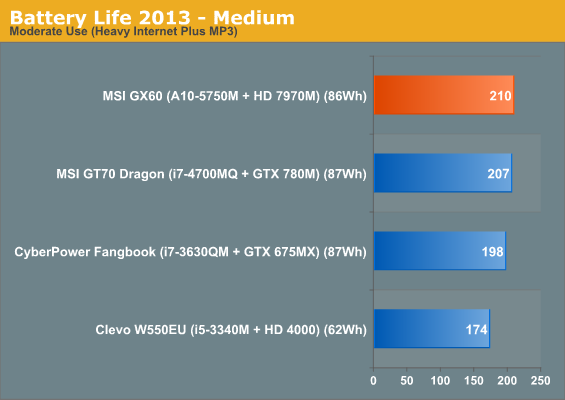
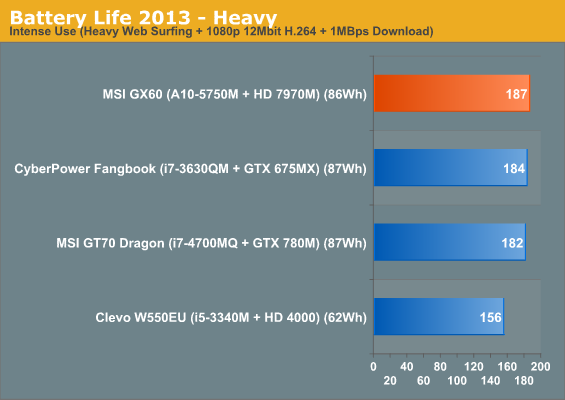
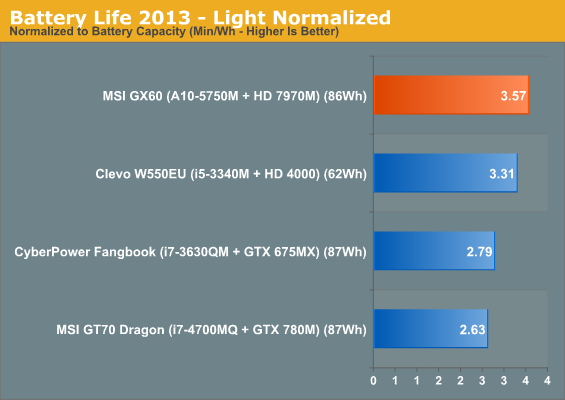
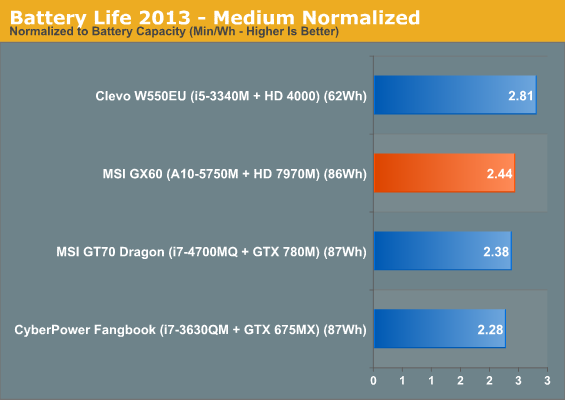
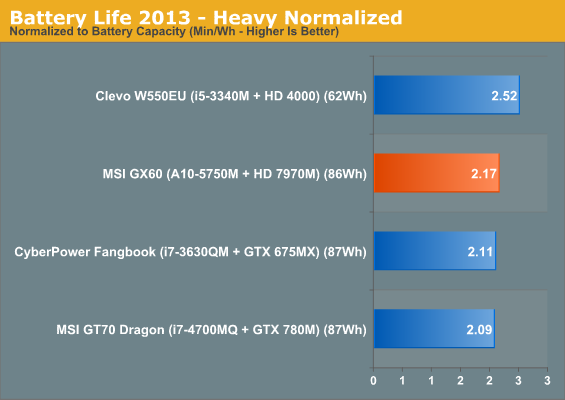
Compared to the other gaming notebooks tested and even the lone Clevo ultrabook, the MSI GX60 is able to actually produce pretty excellent battery life. If all you're doing is casually surfing the internet, the Richland-based APU powering the GX60 can give you a solid five hours of running time.
Heat
While the larger GT70 Dragon Edition had trouble managing its thermals (hopefully fixed with a BIOS update, more on this to come soon), the GX60's dealing with a much lower thermal load. The Intel Core i7-4700MQ coupled with the GeForce GTX 780M results in a peak power draw of almost 150W between the CPU and GPU, while the GX60 tops out at 110W.

I'm not sure what HWMonitor is reading as the "package" temperature, but I can tell you that's not what the APU is running at. For a better idea of how hot the system is running, take a look at the "THRM" value and the temperature value under the Radeon. The GX60 has no trouble dissipating the heat from the A10-5750M and Radeon HD 7970M.










69 Comments
View All Comments
Sabresiberian - Saturday, June 29, 2013 - link
People can talk about how games don't need powerful CPUs all they want, but the fact is, there IS a minimum requirement, and some games DO make use of the top end CPUs available. The more powerful your GPU, the more powerful the CPU needs to be to allow it room to work.This MSI notebook is built using one of the reasons I don't buy pre-built desktops, cutting corners on one part to spend money on another. It's bad design, it doesn't work (at least when the corners are cut to this degree), it makes for a system that is built cheap and shows it in its performance. Shame on MSI, they know better (or at least some of them do - maybe those people aren't in the notebook division).
"Balance" is the key to computer design, just as it is with many things in life.
Dustin Sklavos - Sunday, June 30, 2013 - link
For a while it was true, games by and large didn't really need powerful CPUs. Over about the past year or two that changed and changed *dramatically.* You're getting games that have a tremendous amount of complexity to them; graphics are practically the least of Skyrim's engine's worries, Crysis 3 has an incredibly rich and vibrant environment (despite being kind of crappy), and Tomb Raider is no different. It looks like TressFX takes its pound of flesh out of the CPU *and* the GPU.j_kut - Saturday, July 6, 2013 - link
Skyrim, Crysis3 and Tomb Raider run all maxed out on the GX60 except for 4*MSAA.Only Games not running smooth on this system are MMOs where the CPU is needed for all characters on-screen.
Being a GX60 owner myself I can totally recommend it, except you wanna play GW2 or similar stuff.
YukaKun - Sunday, June 30, 2013 - link
Where's the battery test with just the iGPU like you guys did with the i7?We need those numbers for bragging rights :P
Cheers!
JarredWalton - Sunday, June 30, 2013 - link
Battery testing is done with the dGPU inactive via Enduro, so these are the "best-case" battery life results for this particular notebook.Khenglish - Sunday, June 30, 2013 - link
I know that on optimus systems that the dGPU will still draw a little bit of power even when off. The motherboard still keeps the Vin line active, although the GPU core and memory VR's shut down. I tested this with a multimeter. The fact that the card is still visible to on the pci bus means it's still drawing a little power.It's probably only like half a watt, but it's something.
JarredWalton - Sunday, June 30, 2013 - link
Last I heard from AMD and NVIDIA, it's not even half a watt -- more like 100mW or something in that range. But until we get a system that only has a Richland APU with no dGPU, we can't really test what battery life is like. The GX60 is also a large system relatively speaking, so I'd expect a less performance oriented laptop to get much better battery life with Richland -- same goes for Haswell and IVB laptops.silverblue - Tuesday, July 2, 2013 - link
There's something else that needs to be addressed, if at all possible...The first GX60 had exceptionally poor CPU performance as evidenced by your article eleven days back. From your conclusions, you didn't think that it could have all been down to the CPU (perhaps Enduro was to blame?). So, have MSI fixed that with the second gen GX60, or are we just seeing a (pardon me) turd with go-faster stripes? One or two of the part 1 tests actually underperformed the Trinity prototype which was interesting.
A comparison between both GX60s would be an eye opener.
kwrzesien - Tuesday, July 2, 2013 - link
I'm ready for another page: GAMING PERFORMANCE PART 2Add (or replace) the HDD with an SSD and replace the memory with 2x4GB 1866MHz RAM. Rerun all tests and compare the incremental cost to the more expensive Alienware models. I would argue that the best memory and a good SSD with greatly improve the lags in CPU performance and free the dGPU to perform closer to an i7. Definitely not going to catch it, but closer...
Wolfpup - Tuesday, July 2, 2013 - link
This continues to be an intersting system. I wish AMD would put out a higher end mobile CPU. Since their A series is roughly 50/50 CPU/GPU, there's no reason they couldn't dump the GPU portion and replace it with another 4(ish) cores, and/or clock things higher with a 45 watt TDP.